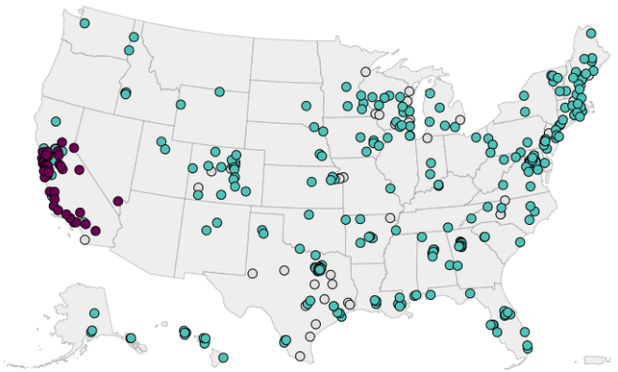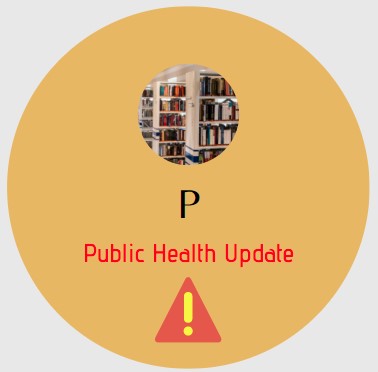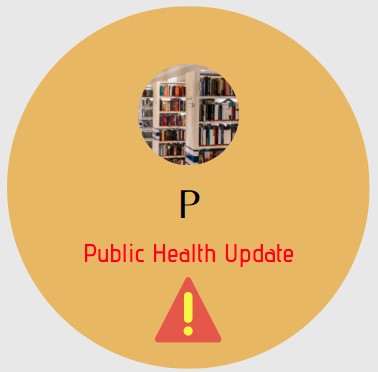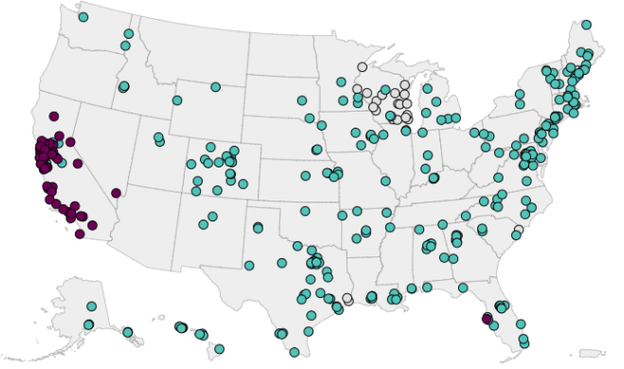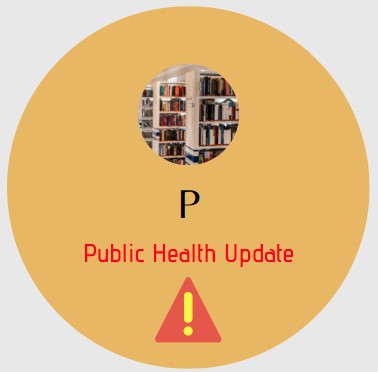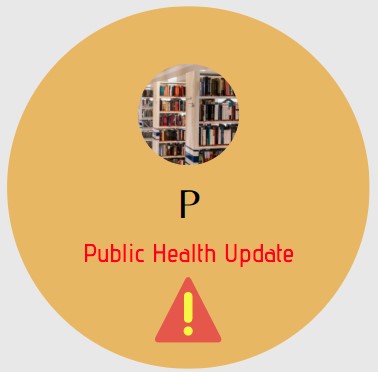Source: US Centers for Disease Control and Prevention, https://www.cdc.gov/bird-flu/spotlights/h5n1-response-11012024.html?ACSTrackingID=USCDC_7_3-DM140015&ACSTrackingLabel=CDC%20A(H5N1)%20Bird%20Flu%20Response%20Update%E2%80%AF%20November%204%2C%202024&deliveryName=USCDC_7_3-DM140015
{Excerpts}
(…)
Situation Update
November 4, 2024 – CDC continues to respond to the public health challenge posed by a multistate outbreak of avian influenza A(H5N1) virus, or “H5N1 bird flu,” in dairy cows, poultry and other animals in the United States. CDC is working in collaboration with the U.S. Department of Agriculture (USDA), the Food and Drug Administration (FDA), Administration for Strategic Preparedness and Response (ASPR), state public health and animal health officials, and other partners using a One Health approach.
Since April 2024, CDC, working with state public health departments, has confirmed H5 bird flu infections in 44 people in the United States. Nineteen of these cases were associated with exposure to H5N1 bird flu-infected poultry and 24 were associated with exposure to sick or infected dairy cows [A][B]. The source of the exposure in one case, which was reported by Missouri on September 6, could not be determined. Serological testing of the contacts of the Missouri case have been reported, and that investigation has concluded.
The 44 cases include 20 cases in dairy farm workers in California, three of which were confirmed by CDC last week and three on Monday, November 4; nine cases in poultry farm workers in Washington state, three of which were confirmed by CDC last week; and one case associated with the Washington poultry outbreak that was confirmed by CDC last week and is pending jurisdiction assignment. Not included in that count are four probable cases — one in a California dairy farm worker and three in Washington state poultry farm workers. While these probable cases were negative on confirmatory testing at CDC, all four met the Council of State and Territorial Epidemiologists (CSTE) probable case definition and have been reported by the states.
Cases in California and Washington have occurred in workers on affected farms. All available data so far suggest sporadic instances of animal-to-human spread. The farm workers in California and Washington state all described mild symptoms, many with eye redness or discharge (conjunctivitis). Some workers who tested positive in Washington reported some mild upper respiratory symptoms. None of the workers were hospitalized. Updated case counts, including by state and source of exposure, are reflected in a table on CDC’s website. To date, person-to-person spread of H5 bird flu has not been identified in the United States. CDC believes the immediate risk to the general public from H5 bird flu remains low, but people with exposure to infected animals are at higher risk of infection.
On the animal health side, since March 2024, USDA has confirmed infected cattle in 440 dairy herds in 15 U.S. states. The number of affected herds continues to grow nationally, with almost all new infections identified in herds in California. USDA reports that, since April 2024, there have been H5 detections in 45 commercial poultry flocks and 30 backyard flocks, for a total of 22.37 million birds affected.
Among other activities reported in previous spotlights and ongoing, recent highlights of CDC’s response to this include:
Laboratory Update
CDC posted a spotlight describing the results of CDC’s first study investigating the effects in ferrets of an avian influenza A(H5N1) virus isolated from a human case in the United States. The study, published on October 28 in the journal Nature, found that when 12 laboratory ferrets were infected with a virus isolated from a human case in Texas (A/Texas/37/2024), all 12 experienced severe and fatal disease. The study also found that this virus efficiently transmitted from infected ferrets to healthy ferrets in the presence of direct contact and, less efficiently, via fomites and respiratory droplets. Preliminary findings from this study, first shared in June 2024, were instrumental in informing early risk assessments related to this outbreak.
To date, CDC has confirmed nine human cases of H5 bird flu in poultry farm workers in Washington state. Genetic sequencing of three of these cases confirms that all are avian influenza A(H5N1) viruses from clade 2.3.4.4b and that all are closely related genetically to the viruses causing infections in poultry on the farm where depopulation was conducted. CDC has successfully obtained partial gene sequences for viruses from three cases in Washington (A/Washington/239/2024, A/Washington/240/2024, A/Washington/247/2024) with other cases pending sequence analysis.
That sequencing information showed that the viruses’ hemagglutinin (HA) is closely related to candidate vaccine viruses (CVV) and that there were no changes in the HA associated with increased infectivity or transmissibility among people. Additionally, there were no mutations associated with reduced susceptibility to available neuraminidase inhibitor treatments and no mutations identified in other genes indicating additional mammalian adaptation. Genetic data have been posted in GISAID and GenBank. Additional data will be posted as they become available. CDC has successfully isolated virus from specimens from three of the nine cases. Attempts to isolate virus from additional specimens are ongoing. Antigenic characterization and antiviral susceptibility testing are underway. Antigenic characterization will inform whether existing H5 bird flu candidate vaccine viruses (CVVs) would provide good inhibition of these viruses.
Epidemiology Update
On Wednesday, October 30, 2024, USDA reported an avian influenza A(H5N1) virus infection in a pig on a backyard farm in Oregon. This is the first time an H5 bird flu infection has been reported in a pig in the United States. Sequence data from birds in the avian influenza A(H5) virus outbreak on this backyard farm showed no mutations that caused concerns related to disease severity or adaptability to humans. The discovery that an avian influenza A virus has infected a new mammal species is always concerning, especially when the virus is detected in pigs, which are susceptible to influenza viruses circulating in pigs, humans, birds, and other species. These viruses can swap genes through a process called genetic reassortment, which can occur when two (or more) influenza viruses infect a single host. Reassortment can result in the emergence of new influenza A viruses with new or different properties, such as the ability to spread more easily among animals or people. Reassortment events have happened in pigs in the past. A series of reassortment events in pigs is believed to have caused the 2009 influenza A(H1N1) pandemic. Based on available information, the risk to the general public remains low; however, CDC is continuing to gather information.
A multilingual CDC field team continues to assist the California Department of Public Health in its efforts to learn more about how the outbreak in California began and how to lower the risk to farm workers with exposure to infected cows. Two staff members are on the ground in California, and additional staff are ready to deploy if needed. CDC staff are assisting with active surveillance efforts, including field assessments of suspected cases and household contacts; testing and treatment; and dissemination of information to farm workers and the community. A separate CDC field team has returned from deployment to Washington state but continues to work remotely with the local health department on data management and epidemiological summaries. There is no evidence of any person-to-person spread in either of the two states or anywhere in the United States.
Surveillance Update
As noted above, CDC has so far confirmed nine cases in Washington.
CDC continues to support states that are monitoring people with exposure to cows, birds, or other domestic or wild animals infected, or potentially infected, with H5N1 bird flu. To date, more than 6,700 people have been monitored as a result of their exposure to infected or potentially infected animals, and at least 340 people who have developed flu-like symptoms have been tested as part of this targeted, situation-specific testing. More information on monitoring can be found at Symptom Monitoring Among Persons Exposed to HPAI.
In addition, since February 25, 2024, more than 57,000 specimens have been tested for avian influenza A(H5) virus or other novel influenza viruses at public health labs. One of the specimens, collected as a part of routine surveillance, was identified as presumptive positive for avian influenza A(H5) virus and was confirmed as H5N1 bird flu positive by CDC.
CDC also continues to monitor flu surveillance data using CDC’s 2024-2025 influenza surveillance strategy, especially in areas where avian influenza A(H5N1) viruses have been detected in dairy cows or other animals, for any unusual trends, including in flu-like illness, conjunctivitis, or influenza virus activity. Overall, for the most recent week of data, CDC flu surveillance systems show no indicators of unusual flu activity in people.
(…)
____
https://etidioh.wordpress.com/2024/11/05/us-cdc-ah5n1-birdflu-response-update-november-4-2024/
#aH5n1 #avianInfluenza #AVIANINFLUENZA #birdFlu #california #h5n1 #health #human #news #oregon #pigs #poultry #updates #USCDC #USA #washington
